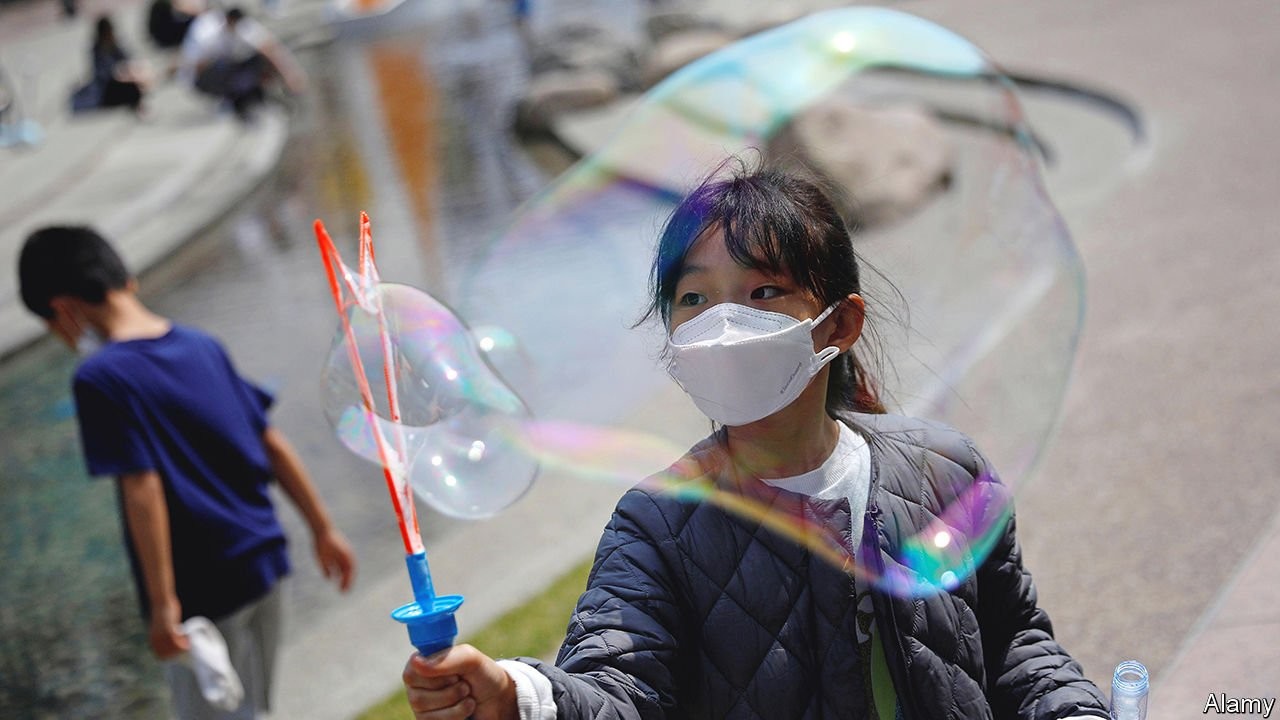Finance & economicsKindred Seoul
South Korea’s economy threatens to become like Japan’s
That could spell enormous trouble

IN 1989, AT the peak of Japan’s economic and financial heyday, few dared suggest the country might one day be supplanted as the richest large nation in Asia. Per person, South Korea was not even half as affluent. But then mighty stock and land bubbles popped in Tokyo, kick-starting several “lost” decades for the Land of the Rising Sun. Meanwhile South Korea’s economy boomed. By 2018 its GDP per person, adjusted for purchasing power, topped Japan’s.
Similarities between the two economies extend beyond converging income levels. Both built their wealth during periods of export-led growth. Now South Korea’s working-age population is shrinking, as Japan’s did after the mid-1990s. Most uncanny are echoes between the financial risks which emerged in Japan in the late 1980s and those mounting in South Korea today. They, too, could trap Asia’s mightiest tiger in the doldrums for decades.
Super-expensive houses have become a major issue in South Korea’s tight presidential election, which takes place on March 9th. The two front-runners—Lee Jae-myung, of the ruling Minjoo Party, and Yoon Seok-youl, of the centre-right People Power Party—have clashed over housing policy throughout the campaign.
The outgoing government’s repeated efforts to rein in the property market, through tighter loan-to-value restrictions on mortgage-lending and steeper taxes on owners of multiple homes, have had little effect. Low interest rates and an ageing population seeking rental income as it nears retirement have proved stronger forces. In the Seoul metropolitan area, home to around half of South Korea’s 52m people, property prices have almost doubled in the past ten years.
There is no specific threshold beyond which the value of all land in a country, relative to the size of its economy, suggests asset prices are unsustainable. But the ratio for South Korea is both high by international standards and relative to the country’s recent history. It now runs at five times its GDP, up from around four times in 2013. At the peak of Japan’s folly, the value of all land rose to 5.4 times GDP, before collapsing through the 1990s.
Pricking South Korea’s apparent bubble would be less dangerous had liabilities not risen in tandem with asset values. South Korean people and firms have been borrowing at a frantic pace. In September last year the country’s household debt stood at 107% of its GDP, compared with 58% in Germany and 79% in America. Non-financial corporate debt runs to 114%, above the average for advanced economies.
This, too, recalls 1980s Japan—and not in a good way. Richard Koo of the Nomura Research Institute in Tokyo warns of a possible “balance-sheet recession”. During Japan’s boom years, asset values and liabilities surged together. When its land-and-stock bubble burst, asset values crumbled, but borrowers still had the same liabilities to repay. That left them in a state of negative equity. As firms and households all rushed to deleverage, the economy shrunk. “Individually they were doing the right thing. Collectively they were destroying the economy,” says Mr Koo.
In 2020 the IMF flagged that South Korea was only one accident away from a damaging balance-sheet recession. Although lending to subprime borrowers was limited, it noted that about half of South Korea’s household credit was either linked to floating interest rates or required large lump-sum repayments, meaning it would need to be refinanced at potentially higher interest rates. It also noted that the country’s many small- and mid-sized firms, dependent on shorter-term bank loans backed by property collateral, looked exposed.
Has the dreaded accident arrived? South Korea was one of the first major economies to raise interest rates during the pandemic, and has now done so three times. Most analysts expect the tightening to continue: the central bank has said it is concerned about both rising inflation and the financial-stability risk posed by soaring asset values. Yet again, that has an 1980s flavour: Japan’s troubles began when the central bank started raising rates rapidly to pop the country’s asset bubble.
The Bank of Korea’s policy of “leaning against the wind”, as Jeong Woo Park of Nomura calls it, is having snowballing effects that may be hard to stop. As a result of stricter credit controls introduced to cool down property prices, mortgage interest rates are accelerating faster than benchmark ones. After surging through pre-pandemic levels, they flirted with decade-highs in January.
The parallel has limits. Japan’s financial institutions were famously poorly regulated, leaving policymakers constantly surprised by the level of damage done to the financial system as crises popped up repeatedly through the 1990s. South Korea’s unusual Jeonse credit system, through which households borrow to fund lump-sum rental payments, makes it difficult to assess how risky household debt truly is.
But the scary similarities will continue to grow as South Korean politicians, central bankers and regulators endeavour to engineer a smooth end to the explosion in asset prices. They have the Japanese experience to learn from. But understanding the worst-case scenario may prove easier than avoiding it. ■
For more expert analysis of the biggest stories in economics, business and markets, sign up to Money Talks, our weekly newsletter.





